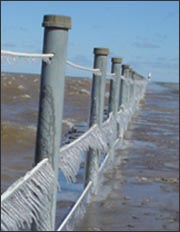(1) The backup scan mirror operating mode (bumper mode) for the Landsat 7 ETM+ was successfully tested in March this year. This operating mode, already in use on Landsat 5 TM, is anticipated to be needed in approximately 1 year on Landsat 7 ETM+ due to wear of the scan mirror bumpers. A more rigorous model was shown to be needed to process Landsat 7 ETM+ and was used to successfully process Landsat 7 ETM+ bumper mode data.

(2) The Landsat 7 ETM+ reflective band radiometric calibration gains continue to be stable to an uncertainty of several tenths of a percent per year. No changes were recommended.
(3) The Landsat 7 ETM+ thermal band radiometric calibration continues to be accurate to within the ability to assess using vicarious calibration, circa ±1%, across the temperature range of about 0° to 20° C. There is some indication that at higher temperatures the calibration deviates from the vicarious calibration measurements. More warm target validations will be conducted this summer in an attempt to resolve this uncertainty.
(4) The Landsat 5 TM bumper mode calibration was shown to be less stable recently due some perturbations introduced by the solar array drive anomaly. These perturbations required more frequent bumper mode calibration updates.
(5) The Landsat 5 TM reflective bands’ radiometric calibration is currently based on a model developed from the internal calibrator and a cross calibration to ETM+. Data acquired from 1984 to present over a Saharan desert site, recently made available by the European Space Agency, suggests that the first half of the instruments history deviates from this model, at least in bands 1 and 2 and perhaps bands 3 and 4 to a lesser extent. A tiger team was formed to reexamine all the data and come up with a recommendation by the next calibration meeting.
(6) The Landsat 5 TM thermal band data continues to show a bias that averages about 1° C from the vicarious data, at least since these data have been rigorously monitored following the launch of Landsat 7 in 1999. The group recommended adjusting for the bias in the Landsat 5 TM processing for the period of 1999 to present and analyzing any older data that can be obtained to see if this bias has been present for a longer period. This calibration update should take place in the next several months.

Be Part of What’s Next: Emerging Applications of Landsat at AGU24
Anyone making innovative use of Landsat data to meet societal needs today and during coming decades is encouraged to submit and abstract for the upcoming “Emerging Science Applications of Landsat” session at AGU24.





